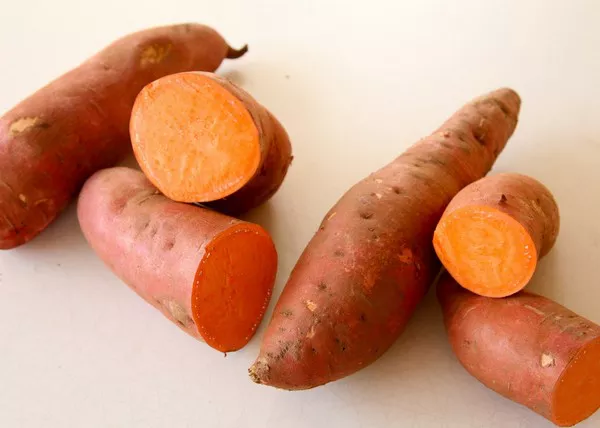As the prevalence of diabetes continues to rise globally, many individuals diagnosed with this chronic condition find themselves questioning their dietary choices. Sweet potatoes, known for their natural sweetness and nutritional benefits, are a popular vegetable that sparks debate among diabetics. This article aims to explore the relationship between sweet potatoes and diabetes, providing evidence-based insights to help individuals with diabetes make informed decisions about including sweet potatoes in their diets.
Understanding Diabetes
Diabetes is a metabolic disorder characterized by elevated blood glucose levels, resulting from either insufficient insulin production or the body’s inability to use insulin effectively. Insulin is a hormone that regulates blood sugar, allowing cells to absorb and utilize glucose for energy. There are two main types of diabetes: type 1 and type 2.
Type 1 Diabetes: This form of diabetes occurs when the body’s immune system attacks and destroys insulin-producing beta cells in the pancreas. Individuals with type 1 diabetes require insulin injections or an insulin pump to manage their blood glucose levels.
Type 2 Diabetes: This is the more common form of diabetes, accounting for approximately 90% of all cases. It typically develops over time due to insulin resistance, where the body’s cells become less responsive to insulin’s effects. Type 2 diabetes can often be managed through lifestyle changes, including diet and exercise, along with medications or insulin if necessary.
Nutritional Profile of Sweet Potatoes
Sweet potatoes (Ipomoea batatas) are root vegetables rich in essential nutrients and antioxidants. They come in various colors, such as orange, purple, and white. The following is a general overview of the nutritional content of 100 grams of cooked, boiled, or baked sweet potatoes:
Calories: Approximately 86 kcal
Carbohydrates: About 20 grams
Fiber: Roughly 3 grams
Protein: Around 1.6 grams
Fat: Negligible amount, less than 1 gram
Vitamins: Rich in vitamins A, C, and B6
Minerals: Good source of potassium and manganese
Antioxidants: Contain beta-carotene, anthocyanins (purple varieties), and other phytonutrients
The Glycemic Index of Sweet Potatoes
The glycemic index (GI) is a scale that measures how quickly a carbohydrate-containing food raises blood glucose levels compared to pure glucose. Foods with a high GI are digested and absorbed rapidly, leading to a more substantial spike in blood sugar, while low-GI foods cause a slower and steadier rise.
Sweet potatoes have a moderate to high GI, with some variation depending on the type and preparation method. Generally, orange sweet potatoes have a lower GI than white sweet potatoes, and boiled or steamed sweet potatoes have a lower GI compared to baked or fried ones. The presence of dietary fiber, as well as the cooking process, can influence the GI of sweet potatoes.
The Glycemic Load of Sweet Potatoes
While the glycemic index provides valuable information, it is essential to consider the glycemic load (GL) of a food, as well. The glycemic load takes into account both the GI and the amount of carbohydrates in a typical serving of the food. This calculation provides a more accurate representation of the food’s overall impact on blood glucose levels.
Sweet potatoes have a medium to high glycemic load due to their significant carbohydrate content, but their impact on blood sugar varies based on serving size and preparation method. Consuming sweet potatoes in moderate portions, especially when combined with protein, fiber, or healthy fats, can help minimize the rise in blood glucose levels.
Health Benefits of Sweet Potatoes for Diabetics
Despite concerns about their glycemic index and load, sweet potatoes offer several health benefits that make them a potentially valuable addition to a diabetic’s diet:
1. Rich in Fiber: Sweet potatoes are a good source of dietary fiber, which slows down the digestion and absorption of carbohydrates. This can help stabilize blood sugar levels and promote better glycemic control.
2. Packed with Nutrients: The abundance of vitamins, minerals, and antioxidants in sweet potatoes contributes to overall health and well-being. Vitamin A, in the form of beta-carotene, is particularly beneficial for eye health.
3. Heart Health: Sweet potatoes contain potassium, which supports heart health by helping to regulate blood pressure.
4. Anti-inflammatory Properties: Some compounds found in sweet potatoes have anti-inflammatory effects, which may benefit individuals with diabetes, as inflammation plays a role in diabetes complications.
5. Weight Management: The fiber content in sweet potatoes can help with satiety, potentially aiding in weight management, a crucial aspect of diabetes management.
6. Slow Digestion: When consumed in their whole form, sweet potatoes can lead to a slower rise in blood sugar levels compared to processed or refined carbohydrates.
Sweet Potato Recipes for Diabetics
Incorporating sweet potatoes into your diet as a person with diabetes can be both delicious and nutritious. Here are three diabetic-friendly sweet potato recipes that are not only low in added sugars but also balanced with protein and healthy fats to help manage blood sugar levels:
1. Baked Sweet Potato with Greek Yogurt and Berries

Ingredients:
1 medium-sized sweet potato
1/2 cup plain Greek yogurt (low-fat or non-fat)
1/4 cup mixed berries (such as blueberries, raspberries, or strawberries)
1 tablespoon chopped nuts (e.g., almonds, walnuts) for added crunch (optional)
1/2 teaspoon cinnamon (optional)
Instructions:
1. Preheat your oven to 400°F (200°C).
2. Wash the sweet potato thoroughly and pat it dry with a paper towel. Pierce the sweet potato several times with a fork to allow steam to escape during baking.
3. Place the sweet potato on a baking sheet lined with parchment paper. Bake for 45-60 minutes or until tender and fully cooked.
4. While the sweet potato is baking, mix the Greek yogurt with cinnamon (if using) in a small bowl.
5. Once the sweet potato is done, let it cool slightly before slicing it open lengthwise.
6. Top the sweet potato with the Greek yogurt mixture, mixed berries, and chopped nuts (if using).
7. Enjoy this creamy, naturally sweet, and nutrient-rich meal that is sure to keep your blood sugar stable and taste buds satisfied.
2. Grilled Sweet Potato and Chicken Skewers

Ingredients:
1 large sweet potato, peeled and cut into cubes
2 boneless, skinless chicken breasts, cut into bite-sized pieces
1 red bell pepper, cut into chunks
1 red onion, cut into chunks
2 tablespoons olive oil
2 cloves garlic, minced
1 teaspoon paprika
1/2 teaspoon cumin
Salt and pepper to taste
Wooden or metal skewers
Instructions:
1. If using wooden skewers, soak them in water for about 30 minutes to prevent them from burning during grilling.
2. In a bowl, combine olive oil, minced garlic, paprika, cumin, salt, and pepper. Add the chicken pieces and toss until they are evenly coated. Cover the bowl and let the chicken marinate in the refrigerator for at least 30 minutes (or overnight for more flavor).
3. Preheat your grill to medium-high heat.
4. Thread the marinated chicken, sweet potato cubes, red bell pepper, and red onion onto the skewers, alternating the ingredients.
5. Grill the skewers for about 10-12 minutes, turning occasionally until the chicken is cooked through, and the sweet potatoes are tender and slightly charred.
6. Serve the grilled skewers with a side salad or quinoa for a complete and well-balanced meal.
3. Sweet Potato and Black Bean Salad

Ingredients:
2 medium-sized sweet potatoes, peeled and diced
1 can (15 oz) black beans, rinsed and drained
1 cup cherry tomatoes, halved
1/4 cup chopped red onion
1/4 cup chopped fresh cilantro
2 tablespoons fresh lime juice
1 tablespoon olive oil
1 teaspoon ground cumin
Salt and pepper to taste
Instructions:
1. Boil the diced sweet potatoes in a pot of water until they are tender but still firm, about 5-7 minutes. Drain and set aside to cool.
2. In a large bowl, combine the cooked sweet potatoes, black beans, cherry tomatoes, red onion, and cilantro.
3. In a small bowl, whisk together the lime juice, olive oil, ground cumin, salt, and pepper to create the dressing.
4. Pour the dressing over the sweet potato and black bean mixture and toss until well combined.
5. Refrigerate the salad for at least 30 minutes to allow the flavors to meld together.
6. Serve this refreshing and fiber-rich sweet potato and black bean salad as a light lunch or a side dish to your favorite protein.
These sweet potato recipes provide a balance of nutrients, flavors, and textures, making them suitable for individuals with diabetes or anyone looking to enjoy the health benefits of sweet potatoes without compromising their blood sugar management.
Considerations for Diabetics
While sweet potatoes can offer health benefits, people with diabetes should be mindful of a few factors when including them in their diet:
1. Portion Size: Moderation is key. Controlling portion sizes can help manage the glycemic response and prevent significant fluctuations in blood sugar levels.
2. Preparation Methods: How sweet potatoes are cooked can impact their glycemic index and load. Boiling or steaming sweet potatoes generally results in a lower glycemic response compared to baking or frying.
3. Balanced Meals: Diabetics should aim for balanced meals that include a combination of carbohydrates, protein, healthy fats, and fiber. Combining sweet potatoes with sources of protein and fiber can mitigate the rise in blood glucose levels.
4. Individual Blood Sugar Response: Every person’s response to sweet potatoes may vary. Some individuals may tolerate them better than others. It’s essential for diabetics to monitor their blood glucose levels and adjust their diets accordingly.
Glycemic Control and Meal Planning
For individuals with diabetes, maintaining good glycemic control is crucial in managing the condition and preventing complications. Meal planning plays a vital role in achieving this goal. When incorporating sweet potatoes into a diabetic meal plan, consider the following tips:
1. Pair with Protein: Combining sweet potatoes with a source of protein can slow down the digestion of carbohydrates, leading to a more gradual increase in blood sugar levels. For example, consider pairing sweet potatoes with lean chicken or tofu.
2. Add Healthy Fats: Including a small amount of healthy fats, such as olive oil or avocado, in a sweet potato-based dish can further help stabilize blood sugar levels and promote satiety.
3. Monitor Blood Glucose: Regular monitoring of blood glucose levels will provide valuable insights into how sweet potatoes affect an individual’s glycemic response. This information can guide future meal choices and portion sizes.
4. Timing Matters: Eating sweet potatoes as part of a meal, rather than on an empty stomach or as a snack, can lead to better blood sugar management.
5. Consult a Registered Dietitian: For personalized dietary guidance, individuals with diabetes should consult a registered dietitian or a certified diabetes educator. These professionals can create tailored meal plans based on individual needs and health goals.
Conclusion
Sweet potatoes can be a nutritious and delicious addition to the diet of individuals with diabetes. Despite having a moderate to high glycemic index and load, their various health benefits, including fiber content, essential nutrients, and antioxidant properties, make them a valuable food option for managing diabetes. As with any dietary choice for diabetics, moderation, portion control, and consideration of individual blood sugar responses are essential factors in maintaining optimal glycemic control. For personalized dietary advice, individuals should seek guidance from healthcare professionals specialized in diabetes management and nutrition. By making informed choices, individuals with diabetes can enjoy sweet potatoes as part of a well-balanced and healthy diet.

